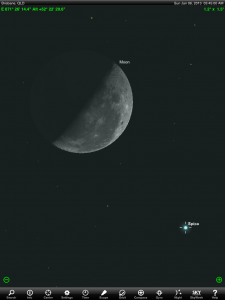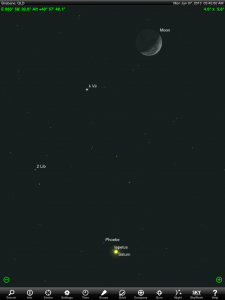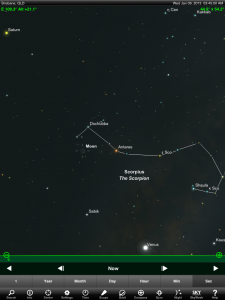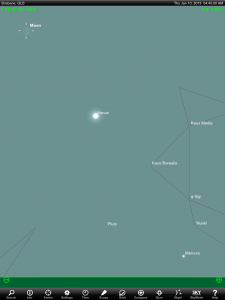These notes are intended to provide a casual sky watcher or someone already into amateur astronomy living in Eastern Australia with a summary of what is happening in the night sky in January 2013. The finder charts have been produced for an observer based in Brisbane (Queensland, Australia) but will be useful for observers elsewhere in Eastern Australia.
Instructions on how to obtain customised satellite viewing information for your location can be found here. If you find this page of interest, you may wish to follow this website automatically using Twitter and the sites RSS Feed.
Planets for January 2013
Jupiter is visible above the North Eastern horizon as a brilliant star as evening twilight ends. It is the brightest object in the night sky beside the Moon and can’t be mistaken for anyone else. Mars is visible very low above the Western horizon in evening twilight ends. It is however too low and too far from Earth to be worth considering pointing a telescope at. Neptune and Uranus are also located low above the Western horizon as evening twilight ends (with Uranus being the higher of the two). A telescope is required to show their tiny discs.
Saturn continues to gain altitude in the morning sky and is located above the Eastern horizon. Saturn rises just after 12.14pm AEST mid-January for locations across South East Queensland. Venus remains visible low above the Eastern horizon in the morning twilight sky. For the first few days of January, Mercury should visible in the morning twilight very low above the Eastern horizon (assuming you have a clear horizon). On 18 January, Mercury reaches superior conjunction – placing it on the opposite side of the Sun to the Earth.
Individual sky events (January 2013)
All times AEST
January 2: Moon located to the right of Regulus (the brightest star in the ancient Greek constellation Leo the Lion). Late evening sky.
January 2: 3pm Earth at perihelion 0.98329 astronomical units
January 4: Mercury at aphelion (furthest in its orbit from the Sun).
January 5: 1:58 pm Last Quarter Moon

January 6: Moon passes Spica (the brightest star in the ancient Greek constellation Virgo the Virgin) in the morning daylight sky. If you are located South of Brisbane, the Moon will occult (cover) Spica for a short period of time.

January 7: Crescent Moon located above Saturn in the morning sky

January 9: Crescent Moon located to the left of Antares (the brightest star in the ancient Greek constellation Scorpius the Scorpion) in the morning pre-dawn sky
January 10: 8 pm Moon at perigee (closest point in its orbit to the Earth) at 360,048 km

January 10: Slim crescent Moon located above and to the left of Venus in the morning twilight sky
January 12: 5:44 am New Moon
January 13: Slim crescent Moon located to the right of and below Mars low above the Western horizon in the bright evening twilight. Difficult.
January 17: Venus at descending node
January 18: 7 pm Mercury in superior conjunction
January 19: 9:45 am First Quarter Moon
January 22: Moon, Jupiter and Aldebaran (the brightest star in the ancient Greek constellation Taurus the Bull) form a temporary triangle in the evening sky. The Moon will occult (block from view) Jupiter the same morning but this won’t be visible from Australia.
January 22: 9 pm Moon at apogee (furthest point in its orbit from the Earth) at 405,311 km
January 24: Mercury at greatest latitude South
January 24: Mars at perihelion (closest point in its orbit to the Sun)
January 27: 2:38 pm Full Moon
January 28: 4 am minor planet Vesta stationary
January 28 – 29: Moon passes above Regulus. Evening sky.
January 31: 2 am Jupiter stationary
For Further Information
Customised Astronomy & Satellite Viewing information
Information on how to obtain customised astronomy & satellite viewing information for your location can be found here on this website.
References
The information in this post has been prepared using the following references.
Astronomy 2013, Quasar Publishing http://www.quasarastronomy.
Sky Safari Pro Ipad app, http://www.southernstars.com/